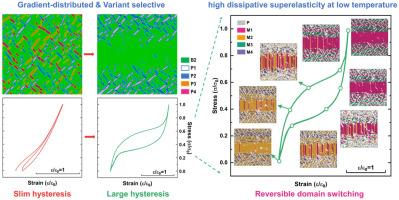形状记忆合金低温下析出诱导高耗散超弹性的相场模拟
IF 9.3
1区 材料科学
Q1 MATERIALS SCIENCE, MULTIDISCIPLINARY
引用次数: 0
摘要
形状记忆合金(sma)在低于马氏体相变完成温度(Mf)时,由于去孪晶主导的变形,通常会完全失去超弹性,这限制了它们在加载和卸载下的可逆应变能力。通过相场模拟,我们引入了一种由沉淀诱导的可逆马氏体畴切换的新机制,以实现低于Mf的超弹性。该机制可以通过调整沉淀配置来精确控制能量耗散和可恢复应变,从而改变sma在低温下的行为。值得注意的是,我们证明了梯度分布、变选择沉淀条件可以解决马氏体相变中高超弹性和显著耗散相结合的挑战。此外,我们的模拟表明,由于不同马氏体变体之间的可恢复域切换,低温下超弹性的临界应力偏离了传统的Clausius-Clapeyron关系。进一步分析表明,低温下的可恢复域切换是由梯度分布、变选择性沉淀条件诱导的短程有序(SRO)马氏体域和远程有序(LRO)马氏体域之间的约束所产生的“内在”恢复力驱动的。这种约束稳定了特定的马氏体变体,在加载和卸载期间实现了显著的可恢复应变,这反过来又有助于观察到的高能量耗散。我们的工作为在要求苛刻的环境中增强sma的功能和多功能性提供了新的策略。本文章由计算机程序翻译,如有差异,请以英文原文为准。


Phase-field simulations of precipitation induced high dissipative superelasticity at low temperatures in shape memory alloys
Shape memory alloys (SMAs) typically lose superelasticity completely below the martensitic transformation finish temperature (Mf) due to detwinning-dominated deformation, which limits their reversible strain capabilities under loading and unloading. Here, using phase-field simulations, we introduce a novel mechanism for precipitation-induced reversible martensitic domain switching to achieve superelasticity below Mf. This mechanism enables precise control over energy dissipation and recoverable strain by tuning precipitation configurations, to transform the behavior of SMAs at low temperatures. Remarkably, we demonstrate that gradient-distributed, variant-selective precipitate condition can resolve the challenge of combining high superelasticity with significant dissipation in martensitic transformations below Mf. Furthermore, our simulations reveal that the critical stress for superelasticity at low temperatures deviates from the traditional Clausius-Clapeyron relationship, due to recoverable domain switching between different martensitic variants. Further analysis reveals that the recoverable domain switching at low temperatures is driven by an intrinsic restoring force arising from the confinement between short-range ordered (SRO) martensitic domain regions and long-range ordered (LRO) martensitic domain regions, induced by gradient-distributed, variant-selective precipitate conditions. This confinement stabilizes specific martensitic variants, enabling significant recoverable strain during loading and unloading, which in turn contributes to the observed high energy dissipation. Our work provides a new strategy for enhancing the functionality and versatility of SMAs in demanding environments.
求助全文
通过发布文献求助,成功后即可免费获取论文全文。
去求助
来源期刊

Acta Materialia
工程技术-材料科学:综合
CiteScore
16.10
自引率
8.50%
发文量
801
审稿时长
53 days
期刊介绍:
Acta Materialia serves as a platform for publishing full-length, original papers and commissioned overviews that contribute to a profound understanding of the correlation between the processing, structure, and properties of inorganic materials. The journal seeks papers with high impact potential or those that significantly propel the field forward. The scope includes the atomic and molecular arrangements, chemical and electronic structures, and microstructure of materials, focusing on their mechanical or functional behavior across all length scales, including nanostructures.
 求助内容:
求助内容: 应助结果提醒方式:
应助结果提醒方式:


